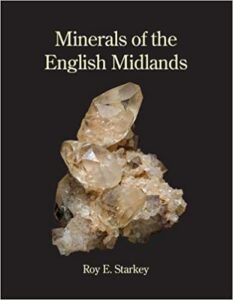Roy E Starkey

Goodness me! This is a massive work (432 pages) – but written with enthusiasm from the heart, with authoritative text, lovely photos throughout, fascinating anecdotes and history, with detailed geological descriptions of all the relevant counties. Now, I’m no expert on minerals, which fall well outside the scope of my interests. However, I cannot praise this book too much.
Obviously, the “English Midlands” is not a geographically defined area, but for this book, it comprises the area from the Welsh border, north to the boundary of Derbyshire and Yorkshire, to the eastern margin of Northamptonshire and southwards, effectively to the M4 motorway. This includes the English counties of:
- Cheshire
- Derbyshire
- Gloucestershire
- Herefordshire
- Leicestershire
- Northamptonshire
- Nottinghamshire
- Oxfordshire
- Rutland
- Shropshire
- Staffordshire
- Warwickshire
- West Midlands, and
- Worcestershire.
Together, these comprise an area of 30,000km2. Fortunately and as beautifully displayed in the book, the ‘English Midlands’ is an area of varied geology and landscapes, and fascinating industrial history.
While there are several excellent publications explaining the industrial heritage and mining history of England and therefore the Midlands (for example, see my review of Measures for Measure: Geology and the Industrial Revolution, by Mike Leeder), but they tend not to cover of the magnificent mineral specimens that have been collected over the years from the area, frequently, the direct result of centuries of extraction. In fact, mining and quarrying have been essential to the area’s economy and, therefore, it has produced a wide range of great mineral specimens. These are displayed in the book by photos in full colour from local and regional museum collections, including at the Natural History Museum in London. Roy Starkey has also obtained access to private and public collections, resulting in the inclusion of previously unpublished photographs of mines, quarries, mineral specimens and artefacts made from them.
And to cover these, this book becomes quite a tome, consisting as I say of 432 pages, most of which consists of descriptions of the minerals found in these counties. This is followed by a review of historical collectors and collections, together with the activities of mineral dealers. The final chapters cover the various decorative stones associated with the area, including and especially Blue John, Alabaster and Ashford Black Marble.
The book is written for anyone interested in the mineralogy and industrial history of the area, visitors to the Peak District National Park, mineral collectors and museum curators. As a guide to British minerals, it is up there with the best.
Roy Starkey read geology at the University of Sheffield and has been a mineral collector for 50 years. He is a past-President and currently (2022) General Secretary of the Russell Society, and founder of the British Micromount Society. He is also author of many articles and papers on British mineralogy and the book, Crystal Mountains: Minerals of the Cairngorms. He was awarded the Marsh Award for Mineralogy in 2016.
Minerals of the English Midlands, by Roy E Starkey, British Mineralogy Publications (2018), 432 pages (paperback), ISBN: 978-0993018237.


